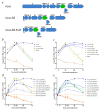Versatile SARS-CoV-2 Reverse-Genetics Systems for the Study of Antiviral Resistance and Replication
- PMID: 35215765
- PMCID: PMC8878408
- DOI: 10.3390/v14020172
Versatile SARS-CoV-2 Reverse-Genetics Systems for the Study of Antiviral Resistance and Replication
Abstract
The COVID-19 pandemic continues to threaten healthcare systems worldwide due to the limited access to vaccines, suboptimal treatment options, and the continuous emergence of new and more transmissible SARS-CoV-2 variants. Reverse-genetics studies of viral genes and mutations have proven highly valuable in advancing basic virus research, leading to the development of therapeutics. We developed a functional and highly versatile full-length SARS-CoV-2 infectious system by cloning the sequence of a COVID-19 associated virus isolate (DK-AHH1) into a bacterial artificial chromosome (BAC). Viruses recovered after RNA-transfection of in vitro transcripts into Vero E6 cells showed growth kinetics and remdesivir susceptibility similar to the DK-AHH1 virus isolate. Insertion of reporter genes, green fluorescent protein, and nanoluciferase into the ORF7 genomic region led to high levels of reporter activity, which facilitated high throughput treatment experiments. We found that putative coronavirus remdesivir resistance-associated substitutions F480L and V570L-and naturally found polymorphisms A97V, P323L, and N491S, all in nsp12-did not decrease SARS-CoV-2 susceptibility to remdesivir. A nanoluciferase reporter clone with deletion of spike (S), envelope (E), and membrane (M) proteins exhibited high levels of transient replication, was inhibited by remdesivir, and therefore could function as an efficient non-infectious subgenomic replicon system. The developed SARS-CoV-2 reverse-genetics systems, including recombinants to modify infectious viruses and non-infectious subgenomic replicons with autonomous genomic RNA replication, will permit high-throughput cell culture studies-providing fundamental understanding of basic biology of this coronavirus. We have proven the utility of the systems in rapidly introducing mutations in nsp12 and studying their effect on the efficacy of remdesivir, which is used worldwide for the treatment of COVID-19. Our system provides a platform to effectively test the antiviral activity of drugs and the phenotype of SARS-CoV-2 mutants.
Keywords: GFP; RNA virus; SARS-CoV-2; molecular clone; nanoluciferase; polymerase; remdesivir; replicon.
Conflict of interest statement
The authors declare no conflict of interest. The funders had no role in the design of the study; in the collection, analyses, or interpretation of data; in the writing of the manuscript, or in the decision to publish the results.
Figures





Similar articles
-
Construction of a Noninfectious SARS-CoV-2 Replicon for Antiviral-Drug Testing and Gene Function Studies.J Virol. 2021 Aug 25;95(18):e0068721. doi: 10.1128/JVI.00687-21. Epub 2021 Aug 25. J Virol. 2021. PMID: 34191580 Free PMC article.
-
A Novel Toolkit of SARS-CoV-2 Sub-Genomic Replicons for Efficient Antiviral Screening.Viruses. 2025 Apr 23;17(5):597. doi: 10.3390/v17050597. Viruses. 2025. PMID: 40431609 Free PMC article.
-
Rescue of SARS-CoV-2 from a Single Bacterial Artificial Chromosome.mBio. 2020 Sep 25;11(5):e02168-20. doi: 10.1128/mBio.02168-20. mBio. 2020. PMID: 32978313 Free PMC article.
-
Reverse genetic systems of SARS-CoV-2 for antiviral research.Antiviral Res. 2023 Feb;210:105486. doi: 10.1016/j.antiviral.2022.105486. Epub 2022 Dec 22. Antiviral Res. 2023. PMID: 36657881 Free PMC article. Review.
-
Reverse genetics systems for SARS-CoV-2.J Med Virol. 2022 Jul;94(7):3017-3031. doi: 10.1002/jmv.27738. Epub 2022 Apr 5. J Med Virol. 2022. PMID: 35324008 Free PMC article. Review.
Cited by
-
A Rapid Method for Generating Infectious SARS-CoV-2 and Variants Using Mutagenesis and Circular Polymerase Extension Cloning.Microbiol Spectr. 2023 Mar 6;11(2):e0338522. doi: 10.1128/spectrum.03385-22. Online ahead of print. Microbiol Spectr. 2023. PMID: 36877070 Free PMC article.
-
Neutralisation resistance of SARS-CoV-2 spike-variants is primarily mediated by synergistic receptor binding domain substitutions.Emerg Microbes Infect. 2024 Dec;13(1):2412643. doi: 10.1080/22221751.2024.2412643. Epub 2024 Nov 13. Emerg Microbes Infect. 2024. PMID: 39392057 Free PMC article.
-
Infectious viruses from transfected SARS-CoV-2 genomic RNA.Front Bioeng Biotechnol. 2023 Mar 30;11:1129111. doi: 10.3389/fbioe.2023.1129111. eCollection 2023. Front Bioeng Biotechnol. 2023. PMID: 37064222 Free PMC article.
-
Cell type dependent stability and virulence of a recombinant SARS-CoV-2, and engineering of a propagation deficient RNA replicon to analyze virus RNA synthesis.Front Cell Infect Microbiol. 2023 Oct 24;13:1268227. doi: 10.3389/fcimb.2023.1268227. eCollection 2023. Front Cell Infect Microbiol. 2023. PMID: 37942479 Free PMC article.
-
Nirmatrelvir-resistant SARS-CoV-2 variants with high fitness in an infectious cell culture system.Sci Adv. 2022 Dec 21;8(51):eadd7197. doi: 10.1126/sciadv.add7197. Epub 2022 Dec 21. Sci Adv. 2022. PMID: 36542720 Free PMC article.
References
-
- Gorbalenya A.E., Baker S.C., Baric R.S., de Groot R.J., Drosten C., Gulyaeva A.A., Haagmans B.L., Lauber C., Leontovich A.M., Neuman B.W., et al. The species Severe acute respiratory syndrome-related coronavirus: Classifying 2019-nCoV and naming it SARS-CoV-2. Nat. Microbiol. 2020;5:536–544. doi: 10.1038/s41564-020-0695-z. - DOI - PMC - PubMed
Publication types
MeSH terms
Substances
Grants and funding
LinkOut - more resources
Full Text Sources
Miscellaneous

